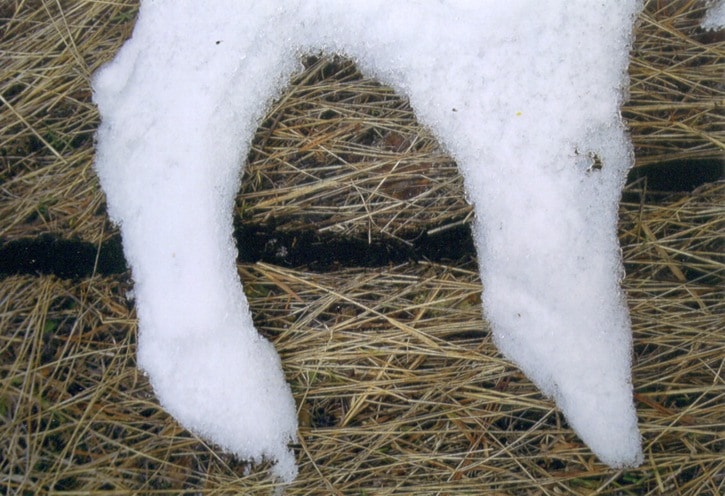As the snow has been melting, I have noticed signs of earlier goings-on previously undisclosed to my searching eyes by a blanket of snow. Concealed by the protective snow covering, little beasties extend their food hunting forays out of sight of hawks, owls and other watchful predators. Over winding trails cut through last summer’s now dry and matted grass and plant stems, voles and mice locate seeds, roots and dried vegetation for winter food. Being opportunists, they will also make use of insect purpose and hibernating caterpillars that they encounter to enhance the diet.
A close examination of the sides of these trails revealed to me neatly trimmed off grass and plant stems. Sharp cutting teeth equip them well for the job of cutting through snow-flattened vegetation. I expect that much of the trimmings are consumed for nourishment. I didn’t notice stockpiles or push-outs of plant debris along the trails. With some small creatures I have noticed compacted material shoved into snow tunnels. This may have been done to get it out of the way or to store for future use. They will also pack soil from their excavations into snow tunnels.
But this community of winter-active creatures doesn’t go entirely unnoticed. While mice and voles are out to get a meal of roots, seeds and dried vegetation, another little member of the mammal class is out to make a meal of these little vegetarians. Those weasel “white coats” easily maneuver their long slender bodies through the snow tunnels to find an unwary vole. When travelling over the snow’s surface, in their slinky gait, they may go entirely unnoticed in their white winter coats.
Shrews are also active under that concealing blanket of snow. Smaller than most mice, they will push away soft snow with their pointed noses, making trails or tunnels to get to a choice food. Their diet is mainly insect and small invertebrate life. They can probably smell something several inches through the snow. They will make good use of tunnels made by other members of this very active winter community.
It seems that many of the mouse-sized members of the mammal class are almost as active in winter as they are in summer. We may add to the list picas, which are active all winter under snow-covered rocks. At lower elevations there are jumping mice that hop over the snow to the next tree or bush where they get down to ground level through the space between the snow and the trunk. For all these, a cover of foliage gives protection in summer while in most winters they have the benefit of a snow blanket. So, in winter, it is business as usual. Snow, appreciate it or not, is just as necessary for us as it is for little beasties. It enables life and processes to continue.
All this goes on under that blanket of snow, while, at the same time, we wish the snow wouldn’t come at all and/or we wish it would just go away. We walk or drive by it not even thinking of what is going on under the snow in the world of little creatures. So, when you sit in your comfy chair, waiting for spring, and look around or up at the mountains or drive over Kootenay Pass, it is not all dead out there. There is life under all that snow and when it melts many secrets will be revealed.
Ed McMackin is a biologist by profession but a naturalist and hiker by nature. He can be reached at 250-866-5747.
